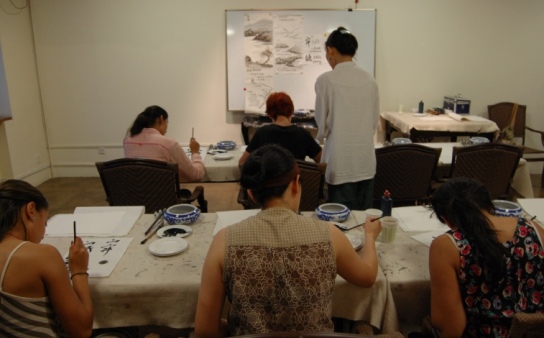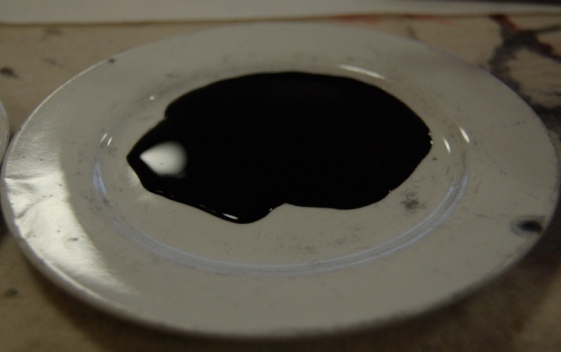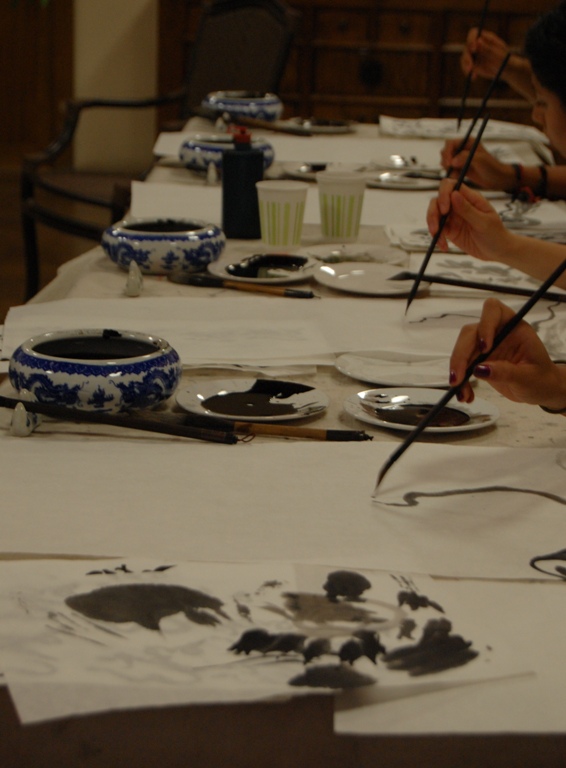Painting the Chinese way: A cultural lesson
At first the room was bustling with excitement, but soon fell to silent meditation. Only the roar of the air conditioner and soft music could be heard in the room for several minutes.
"Before my class, I always say we need to relax and meditate before we start painting,"Zhang Yuan told her six students in class. "Relax your neck, your shoulders, your waist and your knees."
Zhang teaches the landscape painting class at the China Culture Center, a privately owned cultural learning and touring company in northeast Beijing. From 7 p.m. to 9 p.m., Zhang guided her eager students.
|
|
|
Zhang Yuan, who teaches the landscape painting class at China Cultural Center, shows her students how to finish off the replication of her painting, "Silent Ferry," with dots to add detail to the riverbank. |
"In every one of my classes, we do calligraphy first,"Zhang told the class after they were all relaxed. "That way you can get familiar with your brush, and also can practice the calligraphy."
Marie, one of the students who attended Tuesday's class, said the classes are taught "the Chinese way."
"The teacher shows a picture and guides you to make it step by step," Marie said.
Zhang displays a traditional Chinese painting of a riverbank, a work she calls "Silent Ferry."
"The whole scenery at dusk is peaceful and silent," Zhang said. She continued by describing the parts of the painting which the class would recreate — the bank with a ferry boat under a willow in the foreground, with distant islands in the background.
|
|
|
During the calligraphy practice during the class, Zhang Yuan, standing, observes the class Tuesday night to suggest improvements. |
The class emphasizes the typical techniques of Chinese painting while encouraging personal creativity. Zhang explains the proper methods, but doesn't criticize deviations from that.
"The paper has two sides: one smooth, one rough," Zhang said. "Usually we use smooth, but some artists prefer rough. You can choose."
|
|
|
For Zhang Yuan's class, the students practice the calligraphy first, both to learn the characters and to get used to the brushes. |
Zhang guides the students through basic techniques, from selecting the right brush, to varying the intensity of the ink.
"One stroke," she instructed the class Tuesday night. "In Chinese painting we don't use lots of strokes."
|
|
|
Chinese paintings are created almost entirely with dark ink, which is diluted with water to create different shades. |
Cherry Yu, cultural program coordinator for China Cultural Center, said that Zhang is Buddhist, which makes her a very calm and patient teacher.
"We always want to be sure we have very good quality classes," Yu said. "People come back because they like the classes and the teachers."
Indeed, Zhang's class is only one of several classes China Cultural Center offers. According to the center's brochure, lectures, classes and workshops are available in painting, calligraphy, Chinese cookery, Chinese medicine and massage, history, philosophy, Mandarin and Chinese opera.
|
|
|
Students in the landscape painting class paint a willow tree in their replications of the instructor's painting, "Silent Ferry." |
"This place offers so many opportunities," said Jeffrey Hsi, one of the students who is a teacher from New York traveling in China with his wife and two of his students. "We took a stamp-carving class earlier, so we've had two culture classes today."
China Cultural Center also serves as a touring service, with several regular tours each week, such as a boat tour to Summer Palace, in addition to special tours, like camping on the Great Wall of China.
The tours, Yu said, are not usually to places that are commercial and popular.
"This is a culture center. Even for the tours, we focus on the culture programs," she said. "That's why we don't usually take tourists to go shopping, and we don't have trips to places like Shanghai."
The cost for the classes and tours varies depending on the resources involved. Some tours are in and around Beijing, and cost up to 300 yuan (about US$45). For trips which require lodging and airline tickets, the price can range from about US$250 to more than US$3,500, depending on the length of the trip.
Yu said that although their company is not a nonprofit organization, the money they make from the tours often compensates for the money they lose by offering cheap lectures and classes. Even then, she said, they can't afford to pay lecturers very much.
"The lecturers who come don't want money," Yu said. "The just really like Chinese culture and want to share it."
She said that the selection process for lecturers and teachers is not solely based on ability in one's craft.
|
|
|
Calligraphy brushes, often made of animal hair, range in sizes to create lines with different thicknesses. |
"We also like to meet with them to make sure they have the positive energy," Yu said. "Everyone here has the same energy as Zhang Yuan and I."
Zhang said, "I like it here because teaching here is freer than in college because I can use my ideas and my own teaching style."
She also said that sometimes teaching at the cultural center is challenging because they often have a mix of talents — some students who have attended many classes, and some who are just trying Chinese painting for the first time.
"New visitors always feel very fresh and excited about their new experience, while old students are more serious about learning the technique," she said.
"Most foreign people have potential ability with the brush," Zhang said. "I think most people can finish a very good painting."
Everyone who attends the class has a completed Chinese-style painting to carry home with them.
"Out of all the souvenirs they've bought here, this is the coolest," Hsi said.
 0
0 













